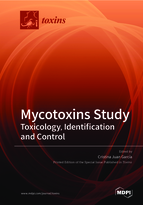Mycotoxins Study: Toxicology, Identification and Control
A special issue of Toxins (ISSN 2072-6651). This special issue belongs to the section "Mycotoxins".
Deadline for manuscript submissions: closed (30 November 2020) | Viewed by 42409
Special Issue Editor
Interests: food safety; mass spectrometry analysis; proteomics; risk assessment; toxicology
Special Issues, Collections and Topics in MDPI journals
Special Issue Information
Dear Colleagues,
The evaluation of the presence of mycotoxins in different matrices is achieved through different analytical tools (including quantitative or qualitative determinations). Studies of mycotoxins used QuEChERS, solid–liquid, liquid–liquid, and solid-phase extraction or inmunoaffinity colums for micotoxins isolation, in combination with chromatographyc equipments (GC or LC) coupled to spectrometry detectors (QTrap-MS/MS, MS/MS tandem, QTOF-MS/MS). All these studies represent key steps in the establishment of the limits of detection, limits of quantification, points of identification, accuracy, reproducibility, and/or repeatability of different procedures. The maximum permitted or recommended levels for mycotoxins in different matrices are comprised within a wide range (including the levels tolerated by infants and animals). In addition, the climatic changes influence the growth of fungi in different matrices, therefore, their control and evaluation are demanded by authorities and safety food systems.
These authorities are concerned not only with the determination of mycotoxins presence but also with the toxicological effects of mycotoxins, and in vivo or in vitro assays are necessary for a complete evaluation. In fact, these assays are the basis for the control and prevention of population exposure to mycotoxins in dietary exposure studies. The last surveys focused on regulated mycotoxins (aflatoxins, fumonisins, and trichothecenes) and emerging toxins such as enniatins and beauvericin in adult consumers, while very few studies have monitored mycotoxins levels in infant products.
The focus of this Special Issue of Toxins is to gather the most recent reports on the toxicological effects of single or combined mycotoxins (genotoxicity, neurotoxicity, or metabolomics effects), the identification of known and unknown mycotoxins, masked mycotoxins, and biometabolized mycotoxins in different matrices (including food, feed, and biological samples), and the development of analytical skills to control their presence. Research papers and review articles describing novelties or overviews, respectively, are welcome.
Prof. Dr. Cristina Juan García
Guest Editor
Manuscript Submission Information
Manuscripts should be submitted online at www.mdpi.com by registering and logging in to this website. Once you are registered, click here to go to the submission form. Manuscripts can be submitted until the deadline. All submissions that pass pre-check are peer-reviewed. Accepted papers will be published continuously in the journal (as soon as accepted) and will be listed together on the special issue website. Research articles, review articles as well as short communications are invited. For planned papers, a title and short abstract (about 100 words) can be sent to the Editorial Office for announcement on this website.
Submitted manuscripts should not have been published previously, nor be under consideration for publication elsewhere (except conference proceedings papers). All manuscripts are thoroughly refereed through a double-blind peer-review process. A guide for authors and other relevant information for submission of manuscripts is available on the Instructions for Authors page. Toxins is an international peer-reviewed open access monthly journal published by MDPI.
Please visit the Instructions for Authors page before submitting a manuscript. The Article Processing Charge (APC) for publication in this open access journal is 2700 CHF (Swiss Francs). Submitted papers should be well formatted and use good English. Authors may use MDPI's English editing service prior to publication or during author revisions.
Keywords
- mycotoxins
- in vivo
- in vitro
- metabolomics
- food safety
- mycotoxin analysis
- genotoxicity
- neurotoxicity







